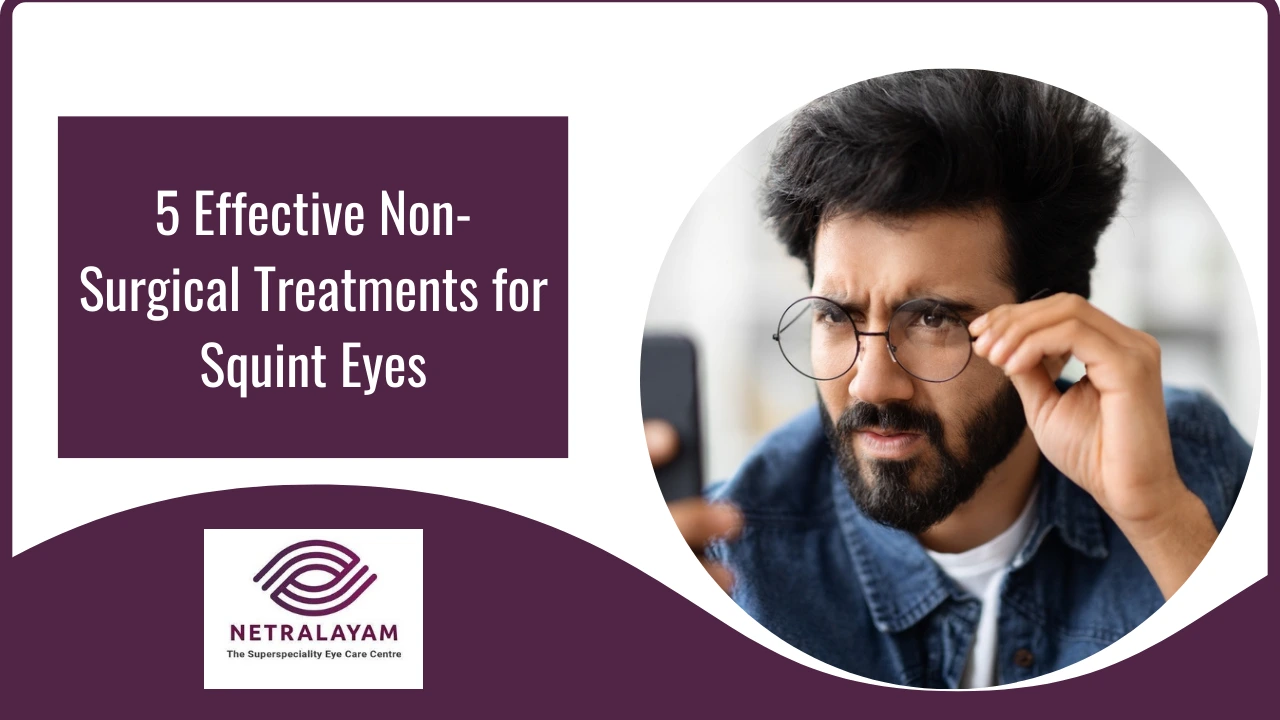Committed to Eye Care with Compassion, Technology and Competency
Committed to Eye Care with Compassion, Technology and Competency

1/12/2025
Squint eyes, or strabismus, can affect both appearance and vision, causing challenges in everyday tasks. In India, the incidence of strabismus ranges from 4% to 6%, with higher rates in premature infants. While surgery is commonly associated with squint correction, several effective non-surgical treatments are available to improve eye alignment. Whether you are looking for squint eye treatment without surgery or squint correction in adults, these non-invasive options provide a viable alternative.
Vision therapy is a non-surgical squint eye treatment that strengthens the eye muscles, helping to improve coordination and alignment. It involves a series of customized exercises designed to enhance the ability of the eyes to work together more efficiently. Vision therapy is highly effective for individuals with mild to moderate squints, especially when started early.
Common exercises may include activities like tracking objects, eye movements, and improving depth perception. Vision therapy can also help individuals with poor convergence, whose eyes fail to work together when focusing on nearby objects.
Ideal candidates for vision therapy include children and adults with mild to moderate squints. The therapy is especially effective when started early and when the patient is fully committed to practicing the exercises. Over time, vision therapy can reduce the need for corrective eyewear or more invasive treatments.
Refractive errors such as nearsightedness, farsightedness, or astigmatism can contribute to eye misalignment for many people with squint eyes. In such cases, corrective eyeglasses or contact lenses can help by adjusting the focus, allowing the eyes to align more naturally. This is a squint eye treatment in adults that may be practical for addressing refractive errors.
Prescription eyewear compensates for vision issues that might lead to squinting. Corrective glasses or contacts can help individuals with certain squints by improving clarity and reducing eye strain. This approach is particularly practical when the squint is related to refractive issues like hyperopia (farsightedness) or myopia (nearsightedness).
While eyeglasses and contacts alone may not fully correct a squint, they can significantly improve overall vision and reduce the risk of eye fatigue. For optimal results, they are often combined with other non-surgical treatments.
Patching, also known as occlusion therapy, is a popular non-surgical treatment for squint eyes, particularly in children. This treatment involves covering the stronger eye with a patch to force the weaker eye to work harder and strengthen the muscles. This approach is commonly used for conditions like amblyopia (lazy eye) that often accompany squints.
By wearing the patch for a specific period each day, the weaker eye is trained to focus better, which can improve alignment over time. Patching is most effective when used consistently and for longer durations. It is typically recommended for children, but adults with amblyopia or squints can also benefit from this technique.
Following the prescribed treatment plan is essential to achieve the best outcomes. Patching is a non-surgical squint treatment that has helped many children and adults regain eye coordination.
Prism lenses are specialized lenses that help align vision without surgery. These lenses bend light as it enters the eye, reducing the effect of misaligned eyes. Prism lenses are effective in correcting double vision, often associated with squints, by redirecting light to allow the eyes to focus correctly.
This treatment is particularly beneficial for individuals with certain types of squints, such as horizontal or vertical misalignment. Prism lenses can be incorporated into eyeglasses, offering a convenient, non-invasive way to correct the condition.
Prism lenses can significantly improve visual comfort and reduce symptoms like eye strain and double vision. They are often combined with other treatments, like vision therapy, to achieve long-term results.
Botulinum toxin injections, commonly known as Botox, are sometimes a non-surgical option for treating squints. Botox temporarily weakens overactive eye muscles, which contribute to misalignment. The injections are administered directly into the eye muscles; over time, the muscles relax, allowing the eyes to align better.
Botox's effects are temporary, typically lasting for a few months, and may require repeat treatments to maintain the improvement. Botox is most effective for individuals with moderate to severe squints and is particularly beneficial for those not candidates for surgery.
While Botox is not a permanent solution, it provides a non-invasive, minimally painful option for those looking to avoid surgery. It is an excellent option for those seeking squint correction without surgery.
Squint eyes can affect vision and appearance, but several effective non-surgical treatments are available to improve alignment and restore comfort. These options offer non-invasive ways to address squints, from vision therapy and corrective eyewear to patching and Botox injections. Early intervention is crucial in achieving the best results and preventing further complications.
By exploring these non-surgical solutions, you can positively impact your eye health and overall well-being. Netralayam offers a comprehensive approach to treating squint eyes. With a team of skilled professionals, the clinic provides personalized care plans tailored to each patient's unique needs. The clinic utilizes advanced technologies and a combination of treatment options to ensure the best possible results for patients.
We're here to support you if you're ready to explore non-invasive treatments and improve your eye alignment. Reach out today for a consultation, and let's work together to find the right solution for your unique needs. Our expert team is ready to assist you in restoring your eye health.
Comments are closed
